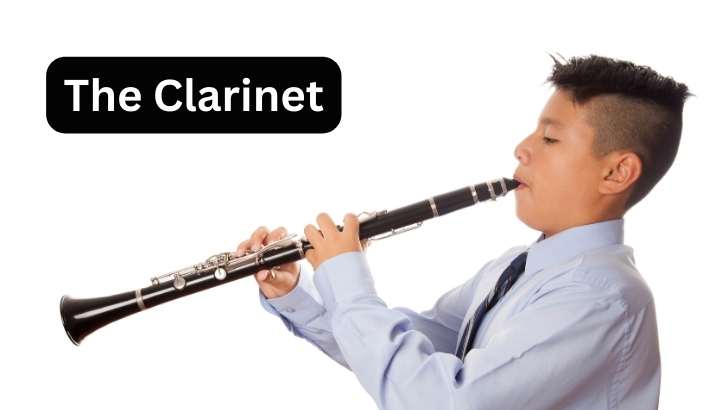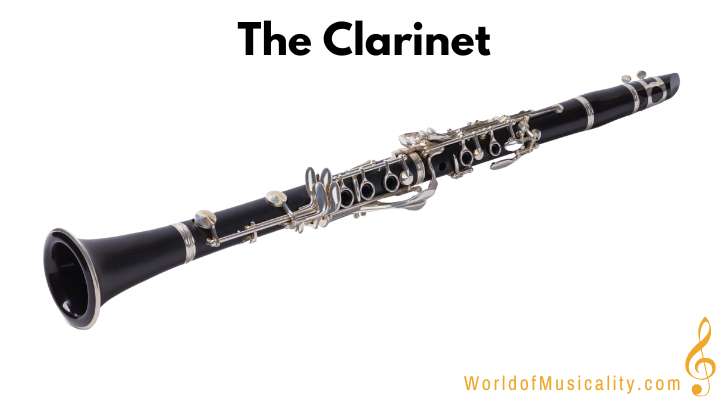
What is a Clarinet Musical Instrument?
The clarinet is a slender woodwind instrument with a cylindrical shape. At 66cm in length, and typically made of black african grenadilla wood, rosewood or plastic, the standard instrument has 7 tone holes and 17 keys.

Clarinet Instrument Facts
- The blowing of air via a single reed at the mouth piece and the arrangement of fingers on the holes and keys directly influences the musical notes and tone of the instrument.
- Musical genres such as orchestral, jazz, and marching and millitary bands commonly feature the clarinet.
- A person who plays the clarinet is called a clarinettist.
In this beginners guide, we’ll explore what the clarinet is, examining what it sounds like, its history, how its made and also delve into some of the great music it has produced over its long history. Search the Table of Contents or watch the video below to get started.
What does the Clarinet sound like?
How to Play the Clarinet
“The ability to play the clarinet is the ability to overcome the imperfections of the instrument. There’s no such thing as a perfect clarinet, never was and never will be.” ~ Jack Brymer (Famous English Clarinettist)
Playing the clarinet involves several steps to produce sound. First, the player holds the clarinet upright and places the mouthpiece between their lips, forming an airtight seal. They blow air into the mouthpiece, causing the reed, a thin piece of cane attached to the mouthpiece, to vibrate. This vibration creates sound waves inside the clarinet’s cylindrical body.
As the air travels through the instrument, it encounters a series of keys and holes along the body. By pressing specific keys and covering or uncovering certain holes with their fingers, the player changes the length of the air column inside the clarinet. This alteration in the air column’s length produces different pitches.
When the player blows harder, the reed vibrates more vigorously, creating louder sounds. Conversely, blowing softer produces softer sounds. Additionally, the player can manipulate the shape of their oral cavity and the position of their tongue to further control the tone and articulation of the sound.
The clarinet’s sound generation relies on the interaction between the vibrating reed and the resonating air column within its cylindrical bore. The cylindrical shape of the clarinet’s body enhances the resonance of the sound waves produced by the vibrating reed. The keys and holes on the instrument enable the player to change the pitch and timbre of the sound by altering the length of the vibrating air column.
Musical Origins
The name “clarinet” derives from the Italian word “clarino,” meaning “little trumpet.” This term reflects the instrument’s early design, which resembled a small trumpet. The suffix “-et” signifies its diminutive size compared to other instruments. Over time, the term “clarinet” came to refer specifically to the woodwind instrument we know today.
Instrument History
| Time Period | Evolution of the Clarinet |
|---|---|
| Ancient Times | Early predecessors of the clarinet, like the chalumeau, emerged in ancient civilizations such as Egypt and Greece. |
| 17th Century | Significant advancements were made by instrument maker Johann Christoph Denner in Germany, laying the foundation for the modern clarinet. |
| 18th Century | Further developments included the addition of keys to extend the instrument’s range and enhance playability. |
| 19th Century | The clarinet gained popularity in orchestras and chamber music ensembles, leading to ongoing refinements in design and manufacturing techniques. |
| 20th Century | Technological innovations, such as the introduction of plastic materials, revolutionized clarinet manufacturing, making instruments more accessible and durable. |
| Present Day | Clarinet design and manufacturing continue to evolve, with a wide variety of models available to cater to different musical styles and player preferences. |
Parts and Construction
The clarinet is made up of six main components that contribute to its sound and functionality.
- On the top of the instrument lies the mouthpiece, housing the reed, a thin piece of cane that vibrates when air is blown through it, generating sound.
- Connected to the mouthpiece is the barrel, which aids in tuning the instrument and adjusting its overall pitch.
- The upper joint contains most keys and finger holes for producing different pitches.
- The lower joint connects to the upper joint and contains additional keys and mechanisms for controlling tone and articulation.
- At the bottom of the clarinet is the bell, which amplifies and projects the instrument’s sound.
- Keys and pads on the clarinet are used by the player to cover and uncover tone holes, altering pitch and timbre.
Each part of the clarinet plays a vital role in producing its distinct sound and enabling the musician’s control and expression.
What is a Clarinet made of?
The clarinet is made from various materials carefully chosen for their acoustic properties, durability, and affordability.
Traditionally, the body of the clarinet is crafted from wood, such as African grenadilla or rosewood, prized for its rich, resonant tone.
In modern times, plastic clarinets have become popular alternatives, particularly for beginner and intermediate players. Plastic clarinets are durable, resistant to changes in humidity, and more affordable than their wooden counterparts.
The keys and mechanisms of the clarinet are typically made from metal alloys, such as nickel-silver or stainless steel, chosen for their strength and resistance to corrosion.
The pads, which seal the tone holes to control airflow, are often made from synthetic materials like cork or felt, providing a reliable seal while minimizing wear and tear.
Some clarinets may feature additional components made from materials like rubber or silicone, such as the thumb rest or key bumpers, designed to enhance player comfort and instrument longevity.
Overall, the choice of materials in clarinet construction reflects a balance between tradition, performance, cost and practicality, ensuring that players have access to instruments that meet their needs and preferences.
Leading Clarinet Instrument Manufacturers
Behind every exceptional clarinet lies the craftsmanship and innovation of leading manufacturers who have dedicated themselves to producing instruments of exceptional quality and precision.
The following table we’ve listed 10 of the more prominent names in the industry, renowned for their commitment to excellence and the art of clarinet making.
| Manufacturer | Country of Origin |
|---|---|
| Buffet Crampon | France |
| Yamaha | Japan |
| Selmer | France |
| Leblanc | France |
| Backun Musical | Canada |
| Schreiber & Sons | Germany |
| Jupiter | Taiwan |
| Ridenour Clarinet | United States |
| Patricola | Italy |
| Amati | Czech Republic |
If you’re a interested in buying and learning to play the Clarinet, check out our Clarinet buying guide for beginners.
Famous Clarinettists
| Musician | Description |
|---|---|
| Benny Goodman | Known as the “King of Swing,” Goodman popularized the clarinet in jazz music during the Swing Era of the 1930s and 1940s. His virtuosic playing and innovative arrangements made him a household name. |
| Artie Shaw | Another prominent figure in the Swing Era, Shaw was a highly skilled clarinettist and bandleader. He achieved fame with hits like “Begin the Beguine” and “Stardust,” showcasing his smooth, lyrical playing style. |
| Richard Stoltzman | Renowned for his versatility and technical mastery, Stoltzman is a celebrated classical clarinettist. He has performed with major orchestras worldwide and is known for his expressive interpretations and improvisational flair. |
| Sabine Meyer | Meyer is a prominent contemporary clarinettist known for her dynamic performances and virtuosic technique. She has collaborated with leading orchestras and conductors, garnering acclaim for her musical sensitivity and artistry. |
| Eddie Daniels | A versatile musician, Daniels has made significant contributions to both jazz and classical music. His fusion of jazz improvisation with classical precision has earned him widespread recognition and numerous awards. |
| Martin Fröst | Fröst is acclaimed for his innovative approach to the clarinet, pushing boundaries with his interpretations and collaborations. His expressive playing and captivating stage presence have earned him a devoted international following. |
| Giora Feidman | Feidman is a master of klezmer music, a traditional Jewish musical style. His soulful playing and passionate performances have helped to revive interest in klezmer clarinet and introduce it to audiences worldwide. |
| Don Byron | Byron is known for his eclectic musical style, blending jazz, classical, and world music influences. His innovative compositions and improvisations showcase the clarinet’s versatility and range in various musical genres. |
| Anat Cohen | Cohen is a versatile clarinettist and saxophonist known for her dynamic performances and innovative compositions. She has received critical acclaim for her adventurous approach to jazz and cross-cultural collaborations. |
| Andreas Ottensamer | Ottensamer is a prominent classical clarinettist known for his lyrical playing and technical prowess. As a soloist and chamber musician, he has earned praise for his elegant interpretations and captivating stage presence. |
Classical Music and the Clarinet
In the realm of classical music, the clarinet has been featured prominently in many musical compositions that showcase its expressive capabilities and versatility. Here are ten classical clarinet tunes that are worth exploring:
“Mozart’s Clarinet Concerto in A Major“ by Wolfgang Amadeus Mozart, composed in 1791, is one of the most beloved works in the clarinet repertoire. It features elegant melodies and virtuosic passages, making it a cornerstone of classical music.
“Johannes Brahms’ Clarinet Sonata in F Minor, Op. 120, No. 1” was composed in 1894. This poignant and introspective piece highlights the deep emotional depth and melodic richness characteristic of Brahms’ compositions.
“Carl Maria von Weber’s Clarinet Concerto No. 1 in F Minor, Op. 73,” written in 1811, is renowned for its dramatic flair and technical demands. It exemplifies Weber’s innovative approach to orchestration and instrumental writing.
“Aaron Copland’s Clarinet Concerto,” composed in 1948, is a modern masterpiece that blends American folk influences with classical forms. Its evocative melodies and rhythmic vitality make it a favorite among audiences and performers alike.
“Johannes Brahms’ Clarinet Quintet in A Major, Op. 114,” written in 1891, is a quintessential chamber music work. It features graceful melodies and intricate interplay between the clarinet and string quartet, showcasing Brahms’ mastery of composition.
“Camille Saint-Saëns’ Sonata for Clarinet and Piano in E-flat Major, Op. 167,” composed in 1921, is a captivating blend of lyrical elegance and virtuosic brilliance. It showcases the clarinet’s versatility and expressive range.
“Carl Maria von Weber’s Concertino for Clarinet and Orchestra, Op. 26,” written in 1811, is a charming and spirited work. It features lively themes and brilliant virtuosity, making it a popular choice for clarinettists.
“Wolfgang Amadeus Mozart’s Clarinet Quintet in A Major, K. 581,” composed in 1789, is revered for its elegant melodies and exquisite interplay between the clarinet and string quartet. It is considered one of Mozart’s finest chamber compositions.
“Johannes Brahms’ Clarinet Sonata No. 2 in E-flat Major, Op. 120, No. 2,” composed in 1894, is characterized by warmth and lyricism. It offers both the clarinettist and pianist opportunities for expressive interpretation.
“Aaron Copland’s Clarinet Concerto,” composed in 1948, is a modern masterpiece that blends American folk influences with classical forms. Its evocative melodies and rhythmic vitality make it a favorite among audiences and performers alike.
The Clarinet in Popular Culture
In popular culture, the clarinet has made its mark through various tunes featured in films, TV shows, and other media. Here are ten clarinet tunes that most people would recognize:
“Rhapsody in Blue” by George Gershwin (1924)
This iconic piece features a memorable clarinet glissando at the beginning, setting the stage for Gershwin’s fusion of jazz and classical styles, making it instantly recognizable in films, commercials, and other media.
“The Pink Panther Theme” by Henry Mancini (1963)
Mancini’s jazzy theme, featuring a playful clarinet melody, is synonymous with the suave and mysterious character of the Pink Panther, making it a staple in film soundtracks and pop culture references.
“Sing, Sing, Sing” by Louis Prima (1936)
Although primarily known for its swinging big band arrangement, “Sing, Sing, Sing” often features a clarinet solo, highlighting the instrument’s prominence in this iconic jazz tune.
“Summertime” from “Porgy and Bess” by George Gershwin (1935)
This timeless jazz standard, with its haunting clarinet introduction, captures the languid atmosphere of a summer evening, making it a popular choice for film and TV soundtracks.
“The Entertainer” by Scott Joplin (1902)
While typically associated with piano, “The Entertainer” has been arranged for various instruments, including the clarinet, and is often used in films and TV shows to evoke a nostalgic, turn-of-the-century vibe.
“Take Five” by Dave Brubeck (1959)
Brubeck’s jazz classic features a memorable clarinet solo, adding a cool and laid-back vibe to this timeless piece, making it a favorite in film soundtracks and commercials.
“Stranger on the Shore” by Acker Bilk (1961)
This instrumental hit, featuring Acker Bilk’s soulful clarinet melody, became a worldwide sensation and remains a beloved tune in popular culture, often evoking feelings of nostalgia and romance.
“The Godfather Theme” by Nino Rota (1972)
Rota’s haunting theme, featuring a plaintive clarinet solo, sets the mood for the iconic mafia film series, evoking a sense of intrigue, danger, and nostalgia.
Further Reading
If you have enjoyed reading about the clarinet, here are five more musical instruments that are closely related to it and which may be of interest:
Bass Clarinet: The bass clarinet is a larger and lower-pitched version of the standard clarinet. It has a longer body and a curved neck, allowing it to produce deeper tones. The bass clarinet is commonly used in orchestras, concert bands, and jazz ensembles to provide a rich and resonant bass line.
Alto Clarinet: The alto clarinet is smaller than the bass clarinet but larger than the standard Bb clarinet. It is pitched a fourth or a fifth lower than the Bb clarinet and has a curved neck similar to the bass clarinet. The alto clarinet has a mellow and expressive tone, often used in concert bands and clarinet choirs.
Basset Horn: The basset horn is a member of the clarinet family with a distinctive pear-shaped body and a bent neck. It is pitched in F or G and has a range extending lower than the standard Bb clarinet. The basset horn is known for its warm and smooth timbre, commonly used in classical and chamber music settings.
Basset Clarinet: The basset clarinet is similar to the basset horn but with a slightly different bore and key system. It is pitched in A or Bb and has a range that extends lower than the standard clarinet. The basset clarinet is used in both classical and contemporary music compositions for its unique tonal qualities.
E-flat Clarinet: The E-flat clarinet is smaller than the standard Bb clarinet and is pitched a minor third higher. It has a bright and penetrating tone, often used for its agility and ability to cut through orchestral textures. The E-flat clarinet is commonly found in concert bands, marching bands, and clarinet choirs.







